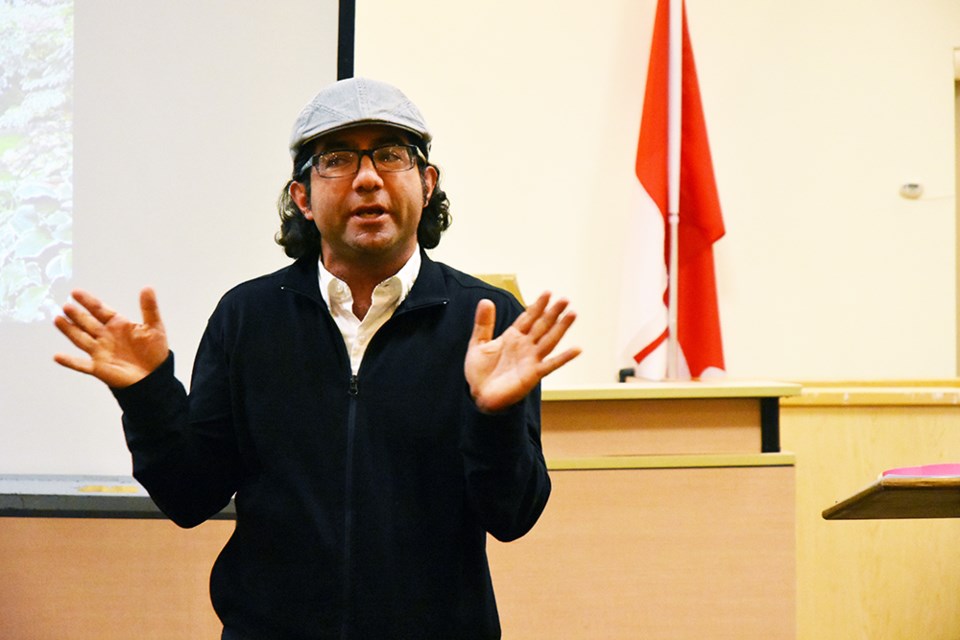Forget everything you’ve ever heard about ‘putting the garden to bed’ for the winter.
“Stop thinking about it. The garden doesn’t stop. In fact, a well-designed garden has interest all year round.”
Paul Zammit, horticulturalist, and director of the Toronto Botanical Gardens for the past decade, offered a new take on fall and winter in the garden. As Zammit told the Innisfil Garden Club on Monday night, “There are things we’re doing right now that invigorate the garden.”
That includes planting bulbs – a “promise’ for the coming year – and collecting and cutting up fallen leaves to create a mulch that returns nutrients to the soil.
And if the gardener has planned well, there will be plenty of interest, colour, and even blooms, heading into the “quiet” season.
Zammit talked about late bloomers – the asters, the geraniums, the mums – that add colour, including an Iris, ‘Immortality,’ that “actually heavily flowers again in the fall.”
Other plants add magnificent foliage to the garden, like the hellebores. “I love them for the fall foliage,” Zammit said. Geraniums, ornamental grasses – “Verbena looks absolutely amazing at this time of year,” he noted. “There are no excuses that things aren’t happening in the garden.”
He encouraged gardeners to plant with an eye to the colour of the foliage, berries, woody stems, the structural shapes of trees and shrubs. “Don’t tell me things aren’t happening in the garden!”
Zammit talked about creating plant partners – putting together plants with contrasting foliage and colours, that share the same soil and moisture preferences – and using foliage, and even seed heads and withered leaves, as part of the palette.
The topic was Planning and Planting for all seasons as Zammit spoke to the Innisfil Garden Club on Visitors Night, offering a blend of information, humour – and controversy.
“I think flowers are lovely, but they’re a bit overrated,” he said, to gasps from the audience, suggesting that foliage, berries and stems can be every bit as colourful and dramatic.
And he challenged gardeners to rethink their standards of beauty. Hellebores, a versatile and hardy group of flowering plants, have been bred to produce “double” blooms – but the doubling of the petals comes at the expense of the nectaries and pollen. Pollinators can’t feed on the doubles.
“What is beautiful? Let us really think about the cost of being beautiful,” he said. The statistic always cited is that “one-third of human food crops depends on bees… I think we’re very selfish.” It’s not just human food, Zammit noted, “Ninety per cent of all flowering plants depend on pollinators, including the trees. This is the point that needs to get out there.”
He didn’t suggest that gardeners give up all of their double blooms and hybrids – but intersperse pollinator-friendly species and ‘singles’ throughout the garden, just to “make sure that the salad bar is always open,” from early spring to late fall.
Planting spring ephemerals underneath later leafing and blooming plants, ensuring there will be colour and interest in spring, summer and fall, is all part of planning the garden. “Read the packages and have a closer look,” said Zammit, checking for early, mid and late-blooming plants. “Extend the season of interest.”
And don’t put the hose away just yet. “Just because the temperature is cooler, doesn’t mean that plants don’t need water. Plants still need moisture,” he said. “We typically don’t lose evergreens to cold, but because they dry out.”
Finally, he suggested using lawns as “a new planting space” – interspersing with crocuses or other spring flowers, “allowing the lawns to have that freedom.” There’s an added benefit, Zammit said: “You have a reason for not cutting your lawn in the spring!”
As for fall and winter, “Remember this is not the end,” he said. “This is the time to give back.”
The club also held its final flower show of 2018, with 37 entries submitted by 11 exhibitors – “Pretty good for this time of year,” said member Jenni Murrell.
Jan Drybrough took a First with her Dahlia; Ritva Heath a First with her New England Aster.
Murrell won Best Chrysanthemum, and took first place with her floral arrangement in the category Witches’ Brew.
Agnes More won First with her ‘Some Like It Hot’ floral arrangement, and took Judge’s Choice with her whimsical ‘Witches’ Brew’ arrangement.
The next meeting of the Innisfil Garden Club will take place on Sunday, Nov. 18 at 4 p.m., at the Churchill Community Centre in Churchill, Innisfil. The AGM and Potluck Supper will include the election of the 2019 executive, presentation of awards and prizes.



